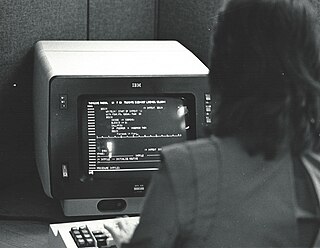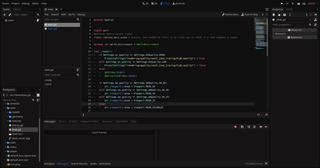Related Research Articles
A file manager or file browser is a computer program that provides a user interface to manage files and folders. The most common operations performed on files or groups of files include creating, opening, renaming, copying, moving, deleting and searching for files, as well as modifying file attributes, properties and file permissions. Folders and files may be displayed in a hierarchical tree based on their directory structure.
IBM mainframes are large computer systems produced by IBM since 1952. During the 1960s and 1970s, IBM dominated the computer market with the 7000 series and the later System/360, followed by the System/370. Current mainframe computers in IBM's line of business computers are developments of the basic design of the System/360.

Multiple Virtual Storage, more commonly called MVS, is the most commonly used operating system on the System/370, System/390 and IBM Z IBM mainframe computers. IBM developed MVS, along with OS/VS1 and SVS, as a successor to OS/360. It is unrelated to IBM's other mainframe operating system lines, e.g., VSE, VM, TPF.

In computer programming, a macro is a rule or pattern that specifies how a certain input should be mapped to a replacement output. Applying a macro to an input is known as macro expansion. The input and output may be a sequence of lexical tokens or characters, or a syntax tree. Character macros are supported in software applications to make it easy to invoke common command sequences. Token and tree macros are supported in some programming languages to enable code reuse or to extend the language, sometimes for domain-specific languages.

The Conversational Monitor System is a simple interactive single-user operating system. CMS was originally developed as part of IBM's CP/CMS operating system, which went into production use in 1967. CMS is part of IBM's VM family, which runs on IBM mainframe computers. VM was first announced in 1972, and is still in use today as z/VM.

MUSIC/SP was developed at McGill University in the 1970s from an early IBM time-sharing system called RAX.
In computing, Interactive System Productivity Facility (ISPF) is a software product for many historic IBM mainframe operating systems and currently the z/OS and z/VM operating systems that run on IBM mainframes. It includes a screen editor, the user interface of which was emulated by some microcomputer editors sold commercially starting in the late 1980s, including SPF/PC.
Disk formatting is the process of preparing a data storage device such as a hard disk drive, solid-state drive, floppy disk, memory card or USB flash drive for initial use. In some cases, the formatting operation may also create one or more new file systems. The first part of the formatting process that performs basic medium preparation is often referred to as "low-level formatting". Partitioning is the common term for the second part of the process, dividing the device into several sub-devices and, in some cases, writing information to the device allowing an operating system to be booted from it. The third part of the process, usually termed "high-level formatting" most often refers to the process of generating a new file system. In some operating systems all or parts of these three processes can be combined or repeated at different levels and the term "format" is understood to mean an operation in which a new disk medium is fully prepared to store files. Some formatting utilities allow distinguishing between a quick format, which does not erase all existing data and a long option that does erase all existing data.

VM is a family of IBM virtual machine operating systems used on IBM mainframes System/370, System/390, zSeries, System z and compatible systems, including the Hercules emulator for personal computers.
IBM CICS is a family of mixed-language application servers that provide online transaction management and connectivity for applications on IBM mainframe systems under z/OS and z/VSE.

CMS Pipelines is a feature of the VM/CMS operating system that allows the user to create and use a pipeline. The programs in a pipeline operate on a sequential stream of records. A program writes records that are read by the next program in the pipeline. Any program can be combined with any other because reading and writing is done through a device independent interface.

XEDIT is a visual editor for VM/CMS using block mode IBM 3270 terminals.

Teleprocessing Network Simulator (TPNS) is an IBM licensed program, first released in 1976 as a test automation tool to simulate the end-user activity of network terminal(s) to a mainframe computer system, for functional testing, regression testing, system testing, capacity management, benchmarking and stress testing.
SCRIPT, any of a series of text markup languages starting with Script under Control Program-67/Cambridge Monitor System (CP-67/CMS) and Script/370 under Virtual Machine Facility/370 (VM/370) and the Time Sharing Option (TSO) of OS/VS2; the current version, SCRIPT/VS, is part of IBM's Document Composition Facility (DCF) for IBM z/VM and z/OS systems. SCRIPT was developed for CP-67/CMS by Stuart Madnick at MIT, succeeding CTSS RUNOFF.
Christmas Tree EXEC was the first widely disruptive computer worm, which paralyzed several international computer networks in December 1987. The virus ran on the IBM VM/CMS operating system.

VPS/VM was an operating system that ran on IBM System/370 – IBM 3090 computers at Boston University in general use from 1977 to around 1990, and in limited use until at least 1993. During the 1980s, VPS/VM was the main operating system of Boston University and often ran up to 250 users at a time when rival VM/CMS computing systems could only run 120 or so users.
CMS EXEC, or EXEC, is an interpreted, command procedure control, computer scripting language used by the CMS EXEC Processor supplied with the IBM Virtual Machine/Conversational Monitor System (VM/CMS) operating system.

In computing, a script is a relatively short and simple set of instructions that typically automate an otherwise manual process. The act of writing a script is called scripting. Scripting language or script language describes a programming language that is used for scripting.

Rexx is a programming language that can be interpreted or compiled. It was developed at IBM by Mike Cowlishaw. It is a structured, high-level programming language designed for ease of learning and reading. Proprietary and open source Rexx interpreters exist for a wide range of computing platforms; compilers exist for IBM mainframe computers.
The CMS file system is the native file system of IBM's Conversational Monitor System (CMS), a component of VM. It was the only file system for CMS until the introduction of the CMS Shared File System with VM/SP.
References
- ↑ Varian, Melinda. "VM AND THE VM COMMUNITY: Past, Present, and Future" (PDF). Retrieved March 14, 2012.
- ↑ "Appendix A: CMS EXEC and EXEC 2 Relationship" (PDF). IBM Virtual Machine/System Product: EXEC 2 Reference - Program Number 5664-167 - Release 2 (PDF). Program Product. IBM. pp. 48–55. SC24-5219-1. Retrieved April 29, 2022.
- ↑ IBM Corporation. "EXEC 2 Processor and CMS EXEC Processor" . Retrieved March 14, 2012.
- ↑ "EXEC 2 Processor and CMS EXEC Processor". IBM .
- 1 2 EXEC 2 Reference (PDF). p. 92. Archived from the original (PDF) on 2017-01-20. Retrieved 2017-12-03.
- ↑ "EXEC 2".